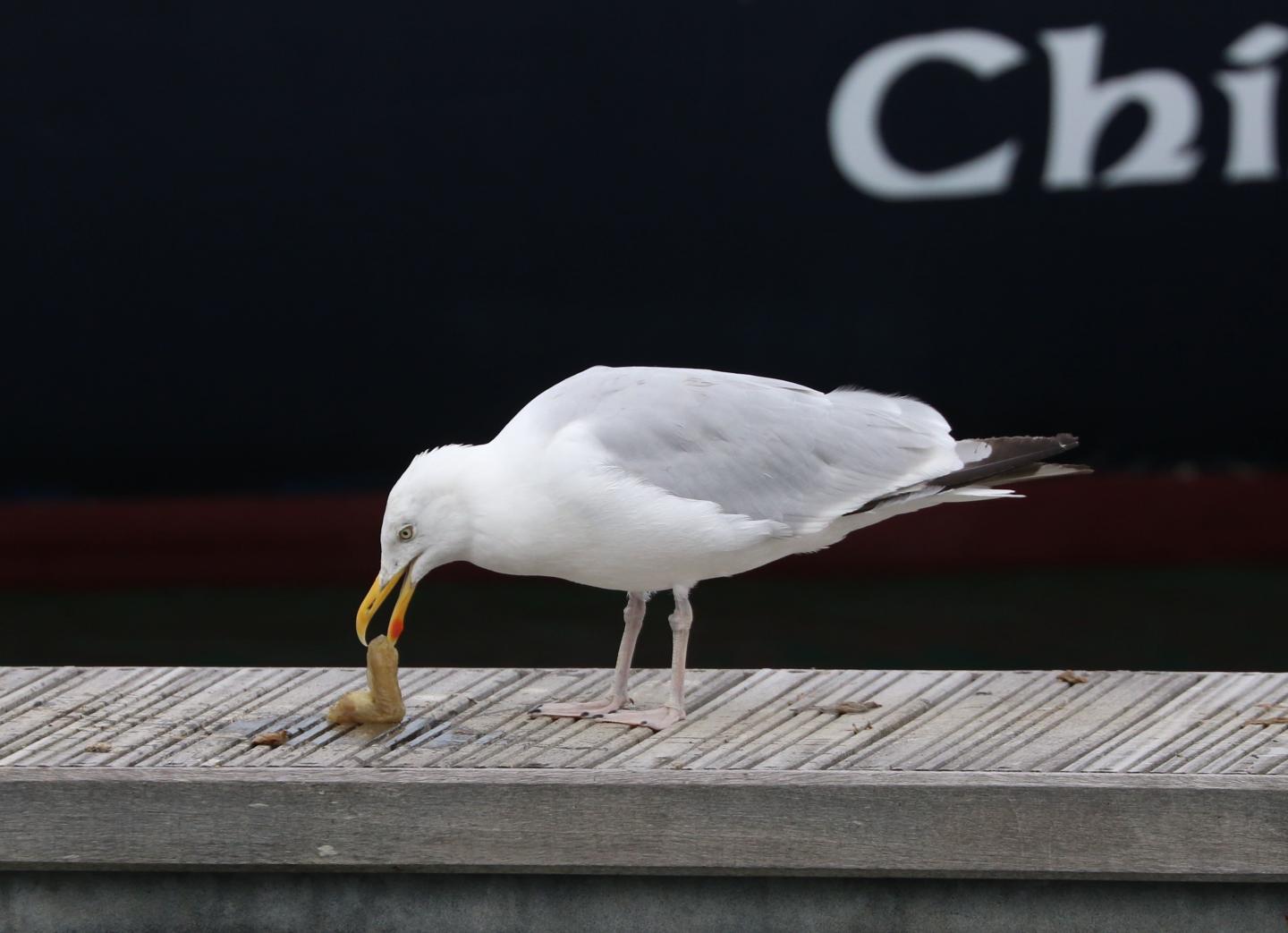
Credit: Tim Blackburn
Observations of Herring Gulls by scientists from the University of Southampton have shown how the coastal birds have developed complicated behaviour to ‘skin’ sea creatures to make them safe to eat. Researchers think this feeding habit may be a response to urbanisation and changes in food availability.
The gulls (Larus argentatus) of Dún Laoghaire Marina at Dublin in Ireland have found a novel way of disposing of the tightly fixed outer layer of sea squirts – an organism which they have learnt to pluck from the underside of pontoons by diving or floating on the water.
Sea squirts, or ascidians, are filter feeding creatures which have an outer layer, known as a ‘tunic’, designed to give protection from predators. This tunic is unpalatable to gulls, however, those living around Dún Laoghaire have overcome this using a particularly clever method.
The birds grasp the sea squirt’s tunic in their beaks, shake it to loosen the soft edible inner body, then switch to hold the inner body (again with their beaks) and shake again until the inedible outer layer is removed.
The team’s report, published in the journal Ecosphere, is the first recorded observation of Herring Gulls feeding using this unusual behaviour.
Project leader Luke Holman, a postgraduate researcher in the School of Ocean and Earth Science at the University of Southampton, comments: “As our coasts have been urbanised over the centuries, gull species have become opportunistic when looking for food. We have all seen them raiding rubbish bins in seaside towns and even swooping to take food straight from people’s hands. But our study shows how the gulls of Dún Laoghaire are adapting in a different way – exploiting a new food source by developing a novel, sophisticated feeding strategy.
“Their dexterity and handling ability is unprecedented and they are able to separate the two halves of the organism either while on land or surface swimming. Their complex technique reinforces the general view that gulls are highly versatile predators – skilled at handling objects and foraging.”
Sea squirts are very successful fouling organisms that cling to the damp surfaces of coastal structures, such as pontoons, and often become invasive when artificially introduced to new areas. Increased development of coastal areas provides them with ideal habitats for proliferating. In addition, shipping and recreational boating has encouraged their spread. This has led to them emerging as a potential new food source along increasingly urbanised coastlines.
The researchers are now keen to know if the behaviour of the gulls in Dún Laoghaire is happening in isolation or whether it represents a wider feeding pattern. The Herring Gull is on the Red List of the British Trust for Ornithology (BTO) ‘Birds of Conservation Concern 4’ because of severe, long-term population decline in the UK and as such it could benefit from new ways of feeding.
###
This study was led by the University of Southampton in collaboration with University College London and the Institute of Zoology (Zoological Society of London).
Notes to Editors
1) For images of the Herring Gulls feeding on sea squirts, or interviews with researchers, please contact, Peter Franklin, Media Relations, University of Southampton. Tel: +44 23 8059 3212. Email: [email protected]
2) The paper Observations of a novel predatory gull behavior on an invasive ascidian: A new consequence of coastal urban sprawl? is published in the journal Ecosphere: https:/
3) The BTO Red List can be found at: https:/
4) For more on the School of Ocean and Earth Science at the University of Southampton visit: https:/
5) More on the project partners can be found at:
https:/
https:/
6) The University of Southampton drives original thinking, turns knowledge into action and impact, and creates solutions to the world’s challenges. We are among the top 100 institutions globally (QS World University Rankings 2019). Our academics are leaders in their fields, forging links with high-profile international businesses and organisations, and inspiring a 24,000-strong community of exceptional students, from over 135 countries worldwide. Through our high-quality education, the University helps students on a journey of discovery to realise their potential and join our global network of over 200,000 alumni. http://www.
Media Contact
Peter Franklin
[email protected]
Related Journal Article
http://dx.



